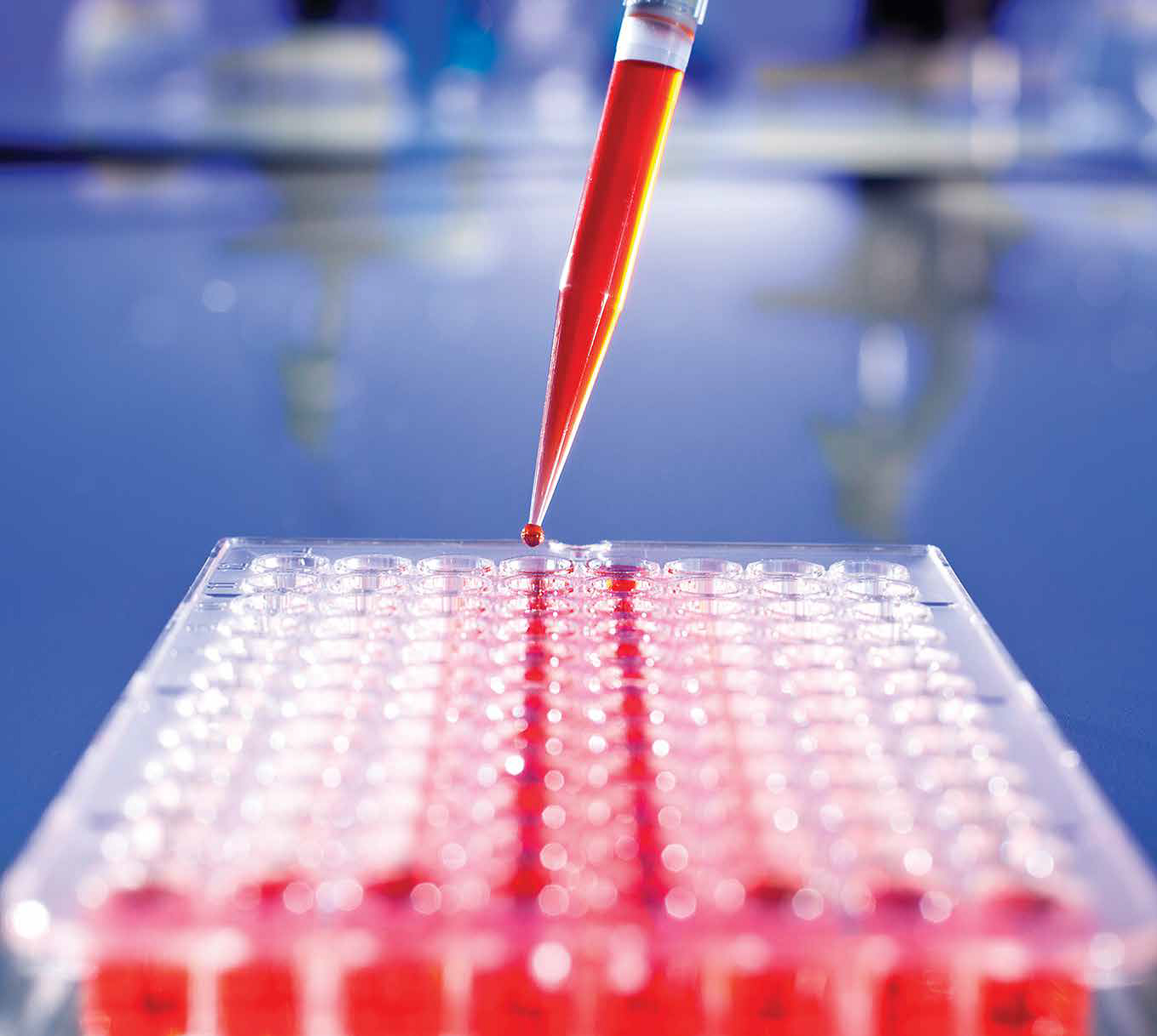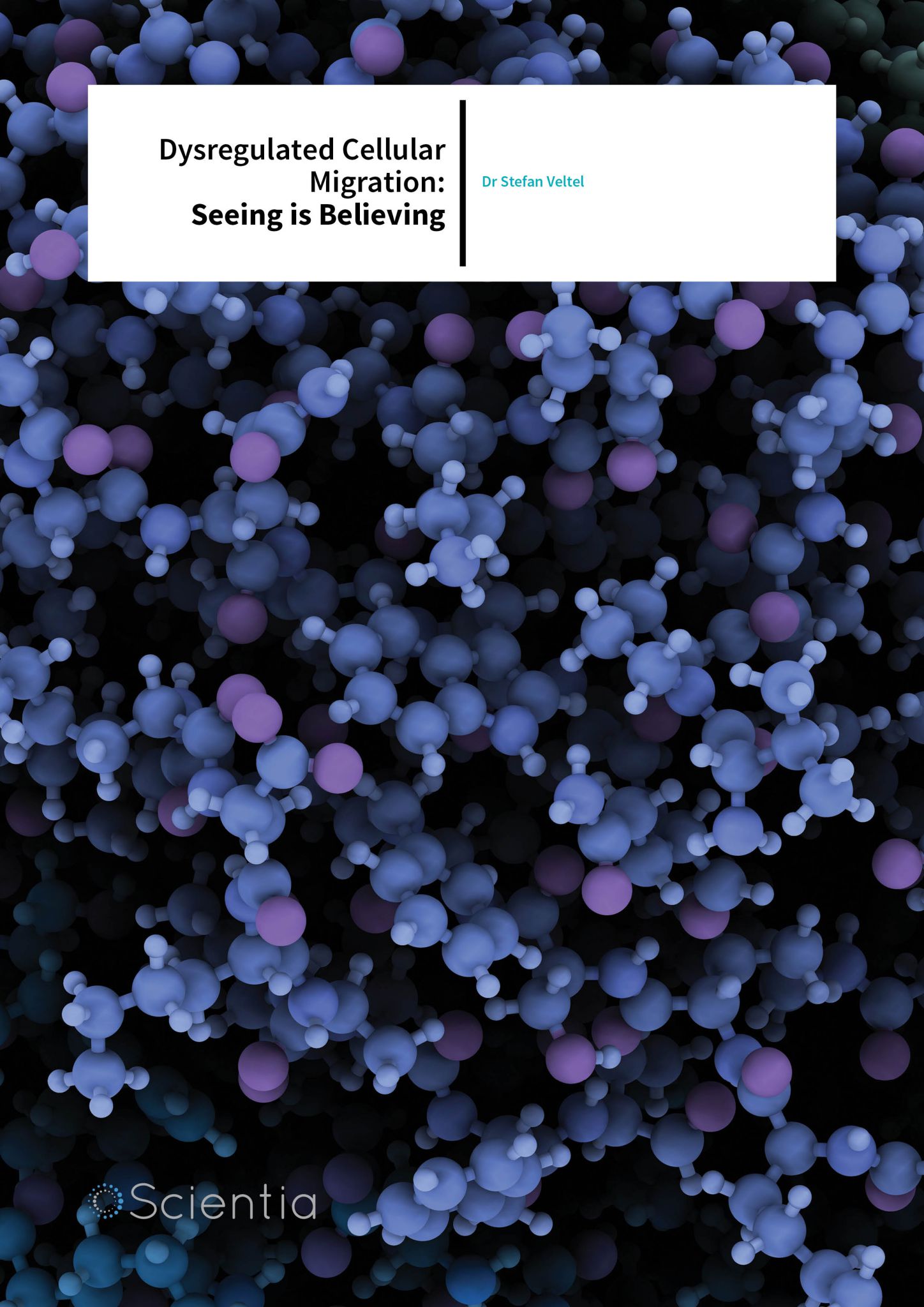Dr Stefan Veltel – Dysregulated Cellular Migration: Seeing is Believing
Dr Stefan Veltel and his colleagues at the Universitätsklinikum Hamburg-Eppendorf in the Institute of Medical Microbiology, and Hygiene, study the molecular mechanisms of small GTPases in the context of various diseases. One protein in their focus is Rab21 and its role in integrin trafficking, cancer progression and metastasis. Another more fundamental mechanistic project involves the time-resolved crystallisation of an enzymatic GAP-GTPase complex.
The Importance of Integrins in Cell Migration and Adhesion
The process by which a cell moves or migrates involves a dynamic interaction between the cell and the extracellular matrix that it is attached to and over which it migrates. Cells can migrate in a variety of ways, and these range from the movement of single cells to the cooperative migration of groups of cells, where intercellular interactions are maintained and cells move together in a highly coordinated manner. Integrins are trans-membrane receptors that serve as the main and best-characterised mediators of the dynamic interactions between the extracellular matrix and the actin cytoskeleton during cell motility. Integrin-based adhesion provides a model for studying the fundamental roles of adhesion in migration.
Integrins are implicated in variety of cellular migrations, including leukocyte trafficking during immune surveillance, the cellular movements that mediate tissue regeneration and repair and migration during embryonic morphogenesis. The importance of integrins is highlighted by the fact that the dysregulation of integrin-mediated adhesion and migration contributes to a variety of human diseases, including cancer. In fact, cancer metastasis starts with cancer cells first detaching from the tumour, migrating to different sites through blood or lymphatic vessels, invading new tissue and adhering to it. Thus, there has been a strong research interest in understanding and potentially targeting integrin-mediated migration to treat cancer, and other diseases. However, studies aimed at understanding cell migration are faced with challenges, because migration is the result of transient, localised adhesion and signalling. The key to really understanding integrin-mediated cell adhesion and migration involves uncovering how the formation and disassembly of integrin-mediated adhesions are regulated temporally and spatially during directed cell migration.
Indeed, Dr Stefan Veltel and his colleagues are interested in the notion that it is not only the activation and deactivation of integrins that is important, but also the endo-/exocytic cycle of integrins plays an important role in mediating integrin function by determining the localisation, the signalling and the fate of integrins. Dr Veltel’s group focuses on the small Ras-family GTP-binding protein Rab21, which is a major regulator in the endocytic trafficking of integrins. At a molecular or structural level, the mode of action of Rab21 remains poorly understood mainly due to the lack of known Rab21-interacting proteins. One of the main goals of Dr Veltel’s research is to gain insight into how Rab21 organises integrin trafficking on a molecularmechanistic level.

Identification of a Novel Interaction Partner of Rab21
Small guanine nucleotide-binding (G) proteins (or GTPases) like Rab21 are ON-OFF switches of the cell. These molecules can be activated by guanine nucleotide exchange factors (GEFs), which reduce the nucleotide binding affinity of GTPases, allowing a fast exchange of GDP to the more abundant GTP. GTPases are switched off again by hydrolysing GTP to GDP – a step that is catalysed by GTPase-activating proteins (GAPs). GTPases transduce the cellular signal to their downstream effector proteins. These effectors can only bind to the GTP-bound form of small GTPases ensuring the signal is transmitted only when the GTPase switch is in the ‘ON’ position. GTPases and their GEFs, GAPs and downstream effectors are potential therapeutic targets for developing drugs to treat various diseases, including cancer.
Dr Veltel and his team are interested in exploring the molecular mechanisms of early integrin trafficking that is regulated by Rab21. ‘We are focusing on the discovery of novel proteins that assist Rab21 to regulate integrin trafficking and hope to both broaden our understanding in the mechanisms of integrin trafficking as well as to find novel targets for cancer therapy,’ he explains. Currently, a limited number of Rab21 binding partners are known (both regulators and downstream effectors). Thus, the mechanistic details of this process are lacking. Dr Veltel aims to identify novel interacting partners of Rab21 during integrin trafficking. Interaction-based screens to identify regulators and downstream effectors of small GTPases are troublesome, because these interactions might occur with low affinities and abundancies in the cell. To increase the specificity of such a screen, Dr Veltel’s group combined the isolation of cellular protein complexes with quantitative mass spectrometry.
To conduct these screens, Dr Veltel’s team created GFP-tagged active and inactive versions of Rab21 and cloned them. In order to purify the interaction partner of Rab21, they isolated cellular GFP-Rab21 complexes, to capture Rab21. They used the MDA MB-231 breast cancer cell line, as this is an established model for aggressive and strongly metastasising cancer cells. From more than 10 experiments, the team repeatedly identified several potential interacting proteins of Rab21 by comparing their amounts in immunoprecipitations of GFP-Rab21 WT or the GFP-Rab21 active mutant (Q78L) to GFP alone or the GFPRab21 inactive mutants (T33N, D135N). The protein quantification was done by mass spectrometry using the SILAC method (stable isotope labelling by amino acids in cell culture) in strong collaboration with the group of Matthias Selbach from the MDC in Berlin. Surprisingly, Dr Veltel and his colleagues identified a few actin-binding proteins to be among the best hits from the screen. Together with microtubules and intermediate filaments, actin filaments built up the cytoskeleton. Microtubules have been known for a long time to be the major cellular highway for vesicular transport inside the cell. In contrast, the role of actin filaments in vesicular transport processes are less established. Major parts of the actin cytoskeleton are localised close to the plasma membrane and are coupled to it via integrin and integrin-binding proteins. This peripheral actin ring stabilises the cellular cortex and its dynamic behaviour is very important for a cell to be able to migrate.
A direct physical interaction between Rab21 and actin-binding proteins as true GTP-dependent downstream effectors of Rab21 could link actin to vesicular trafficking processes. This might happen close to the plasma membrane after the initial endocytosis of integrins when integrins are subsequently transported to different destinations in the cell.
The current research in the Veltel lab concentrates on the function of one actinbinding, an actin-bundling protein. Recent data from the lab shows that this protein is strongly regulating early trafficking steps of integrin in alliance with Rab21. Mechanistically, the silencing of the actinbundling protein effectively reduces the speed of Rab21 vesicles as shown by live cell imaging with TIRF microscopy methods. As a result of modulating integrin trafficking, the silencing of this protein also effects adhesion and migration of MDA-MB-231 breast cancer cells. This could have a direct clinical impact. The collaboration partner of Dr Veltel, Dr Leticia Oliveira-Ferrer from the UKE, found out that patient samples from triple-negative breast cancers (TNBCs) – a very aggressive and metastasising form of breast cancer – show a higher expression of the actin-bundling protein than milder forms of breast cancer. This puts the Rab21 interaction partner into the place of a potential therapeutic target for the treatment of breast cancer.

‘We are focusing on the discovery of novel proteins that assist Rab21 to regulate integrin trafficking and hope to both broaden our understanding in the mechanisms of integrin trafficking as well as to find novel targets for cancer therapy’
A Deeper Understanding of Signal Transduction – ‘Seeing is Believing’
In the studies mentioned above, Dr Veltel’s group focused their efforts on understanding the signal transduction related to cell migration and adhesion using biochemical and cell biological methods to identify an important regulator of Rab21. In another aspect of his studies, Dr Veltel’s team takes their investigation on signal transduction to a deeper level.
To really understand how signalling proteins function, it is necessary to uncover the time-ordered sequence of events that lead to the signalling state. Specialised, but widely used techniques to obtain information of signalling proteins on an atomic level are methods in structural biology like X-ray crystallography, NMR or electron microscopy. For highest atomic resolution, X-ray crystallography is still the method of choice. However, Dr Veltel tells us that ‘a pitfall of this classical method is that we can only see static structural snapshots, but not the dynamics of the reaction so far.’ Progress has been made in the field of time-resolved structure biology in the description of electron transport reactions in the photosystem II of plants. In contrast, information regarding time resolved structural studies of enzymatic reactions is extremely limited. When the messenger is a chemical molecule, the time required to diffuse though a crystal and bind in the active site of a signalling protein is typically far longer than the timescale that occurs when protein conformational changes occur. Therefore, chemical-based signalling is not readily compatible with structural studies that use fast time-scales.
Dr Veltel’s group aims to understand the structural determination of the kinetics of the enzymatic reactions of small GTPases and their co-enzymes. As mentioned above, this system is important in cell biology and particularly impacts disease processes, such as cancer. Given that small GTPases of the Ras superfamily (like Rab21) serve as molecular switches that cycle between a GTP-bound active and a GDP-bound inactive, and this switch is catalysed by GEFs and GAPs, it is important to understand how these reactions occur temporally. The intrinsic GTP hydrolysis of small GTPases is typically very slow, occurring in minutes to hours. However, in the cell, GAP proteins accelerate the GTP-hydrolysis reaction to faster than 1/sec in order to quickly deactivate the GTPase. Studies using spectroscopic FTIR measurements show that the GAP-assisted GTP-hydrolysis can be divided into different reaction steps with different time-frames. However, up until now, there are no high-resolution X-ray structures available that reflect the single kinetic steps of this reaction, and the enzymatic influence of certain residues in the GAP and GTPase is only deduced from static protein structures in combination with biochemical and spectroscopic experiments. Dr Veltel’s group has set forth experiments to determine the time resolved structural characterisation of a GAP-catalysed GTPase reaction. This challenging project requires expertise from different scientific disciplines. Dr Veltel collaborates with structural biochemists, physicists and electrical engineers from the DESY (Deutsches Elektronen Synchrotron) to combine knowledge of the biological process with protein crystallography and laser physics. This interdisciplinary research project is funded by PIER – a strategic partnership between DESY and Universität Hamburg, which aims to support cutting edge science in Hamburg

Structural ‘Movie’ of an Enzymatic Reaction
To characterise a GAP-catalysed GTPase reaction, Dr Veltel’s group has chosen the Arl3-RP2 complex as the GTPase-GAP pair. The gene encoding the GAP protein RP2 is highly mutated in patients with X-linked Retinitis pigmentosa, with mutational hotspots in residues catalysing the GAP reaction on Arl3. In addition to its clinical relevance, they also chose this system as a model system for time-resolved structure determination because Dr Veltel had previously crystallised the complex of Arl3 and RP2 in the presence of a nonhydrolysable GTP-analogue and solved the structure using classical X-ray structure determination methods.
In order to not hydrolyse the Arl3-bound GTP in its complex with RP2, a hydrolysisprotected GTP – caged-GTP – has to be used in crystallisation setups. In the crystal, the reaction can be started by de-caging the GTP with high intensity UV-laser light. Dr Veltel’s team is able to capture millisecond time-resolved snapshots of the Arl3/GAP RP2 structure using the pump-probe method. This method involves a laser pulse (pump) that photoactivates a caged-GTP molecule that is complexed to a protein, after which a suitably delayed X-ray pulse (probe) passes through the crystal and records its diffraction pattern on a 2D detector.
The central step in the time-resolved crystallography experiments of enzymatic reactions is the simultaneous initiation of the reaction start for all of the molecules in the crystal. Therefore, Dr Veltel’s group is focussing on optimising the crystal size in correlation to the required energy supplied by a high intensity pump laser. By elucidating the experimental parameters that are necessary to trigger and to synchronise the reaction, they will record the diffraction data and process the data with polychromatic or monochromatic X-ray pulses using a serial crystallography approach. The time difference between the UV-laser inducing the start of the reaction and the X-ray laser determining the structure reflects the structural snapshot at one certain reaction time of the enzymatic reaction. A sequence of the snapshots after (for example) 10 ms, 50 ms, 100 ms, 500 ms, 1 sec creates the molecular movie of the enzymatic GAPGTPase reaction. Overall, this project is a novel ‘proof-of principle’ methodological approach that promises a high scientific impact on the structural determination of enzyme kinetics.
Meet the researcher

Dr Stefan Veltel
Institute of Medical Microbiology, Virology and Hygiene AG Medical Biochemistry
Universitätsklinikum Hamburg-Eppendorf
Hamburg, Germany
Dr Stefan Veltel is the head of a research group at the Universitätsklinikum Hamburg-Eppendorf in the Center for Diagnostics at the Institute of Medical Microbiology, Virology and Hygiene. Dr Veltel received his Ph.D. from the Max-Planck-Institute in Dortmund, Germany and did his postdoctoral research at the VTT (State Technical Research Center – Technology for business) in Turku, Finland. Over the course of his career, he has been presented with many awards, including the Feodor Lynen Stipendium (Alexander von Humboldt-Stiftung) and an EMBO Long-Term-Fellowship
CONTACT
E: stefan.veltel@gmail.com
T: (+49) 40 7410 58184
W: https://www.uke.de/english/departments-institutes/institutes/ medical-microbiology-virology-and-hygiene/research/working-groups/ ag-veltel.html
KEY COLLABORATORS
Professor Matthias Selbach, Max Delbrück Zentrum, Berlin
Professor Johanna Ivaska, University of Turku, Finnland
Professor Martin Aepfelbacher, University Medical Center, Hamburg
Dr Sabine Windhorst, University Medical Center, Hamburg
Dr Leticia Oliveira-Ferrer, University Medical Center, Hamburg
Dr Markus Perbandt, DESY (Deutsches Elektronen Synchrotron), Hamburg
Dr Guoqing Chang, CFEL, Hamburg
FUNDING
DFG (VE 750/2-1)
PIER Seed Projects
REFERENCES
A Arjonen, J Alanko, S Veltel and J Ivaska, Distinct recycling of active and inactive beta1 integrins, Traffic, 2012, 13, 610–625.
JK Rantala, J Pouwels, T Pellinen, S Veltel, P Laasola, et al., SHARPIN is an endogenous inhibitor of beta1-integrin activation, Nature Cell Biology, 2011, 13, 1315–1324.
A Mai, S Veltel, T Pellinen, A Padzik, E Coffey, et al., Competitive binding of Rab21 and p120RasGAP to integrins regulates receptor traffic and migration, Journal of Cell Biology, 2011, 194, 291–306.
S Veltel, R Gasper, E Eisenacher and A Wittinghofer, The retinitis pigmentosa 2 gene product is a GTPase-activating protein for Arf-like 3, Nature Structural & Molecular Biology, 2008, 15, 373–380.
S Veltel, A Kravchenko, S Ismail and A Wittinghofer, Specificity of Arl2/ Arl3 signaling is mediated by a ternary Arl3-effector-GAP complex, FEBS Letters, 2008, 582, 2501–2507.


